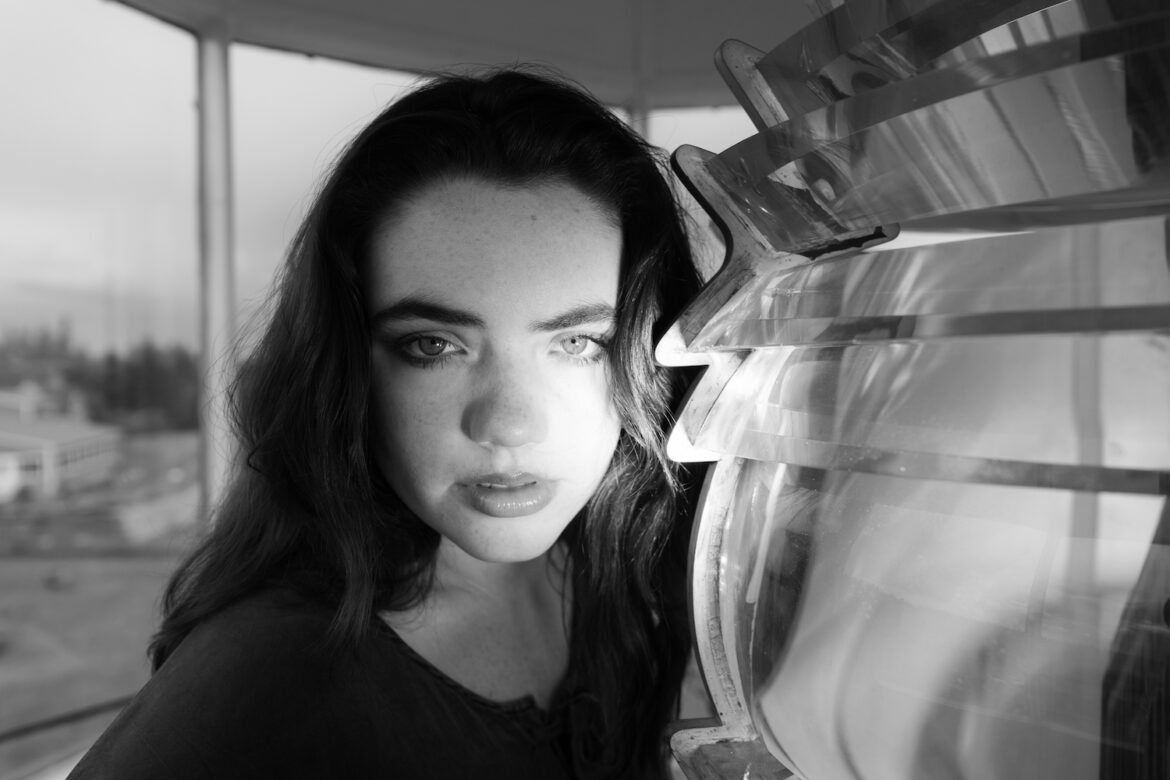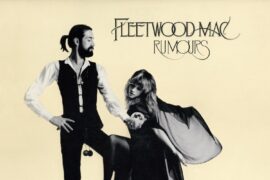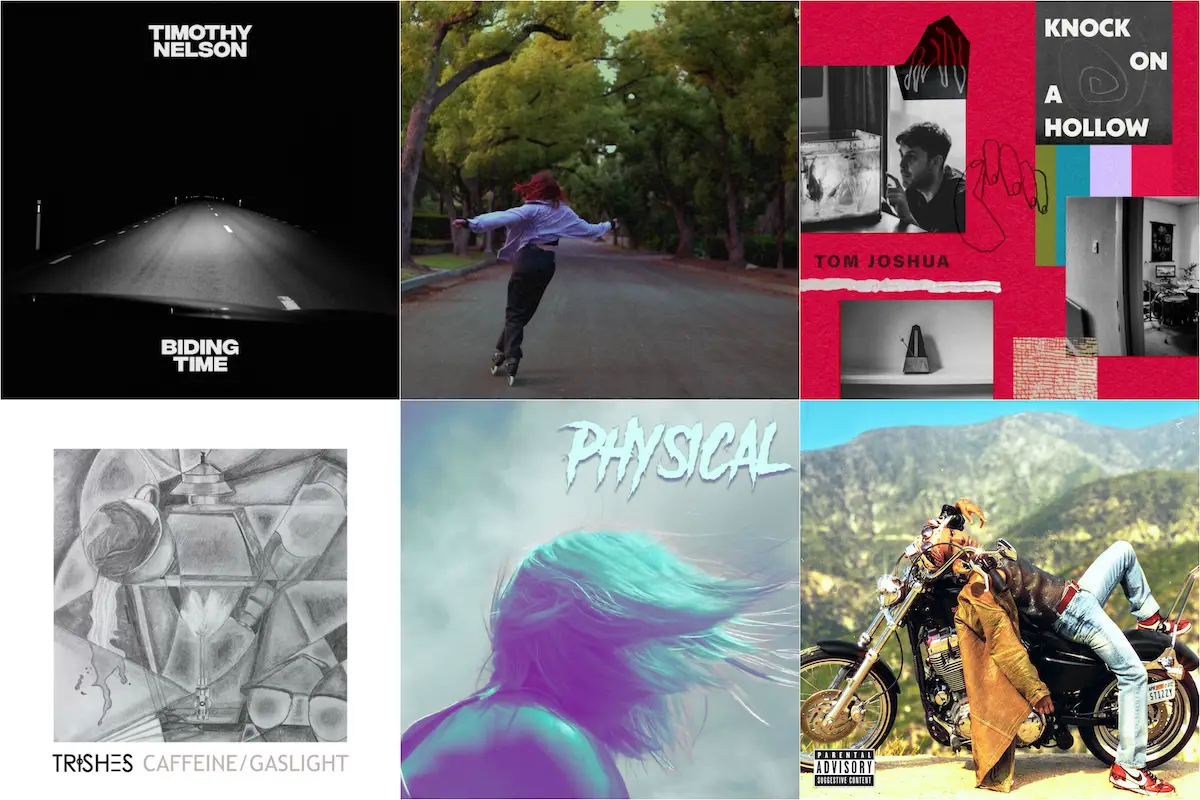Alt-pop singer/songwriter Genevieve Stokes talks to Atwood Magazine about learning to trust herself in the making of her debut album ‘With a Lightning Strike,’ writing music through moments of panic and crisis, her love of Maine, and her excitement about touring.
by guest writer Alexandra Jhamb Burns
‘With a Lightning Strike’ – Genevieve Stokes
Mid-October is a unique time of year in Maine.
For those of us who grew up here, it is more a feeling than it is a season. The leaves have turned their yellows and oranges and fallen to form a slippery bed over the forest floor. The trees are achy and they moan out in pain, their creaky joints mimicking a soft scream in the wind. My fingers are always cold and I huff hot breath into my hands, feeling so acutely alive and reminded constantly of death. It is both comforting and distressing – this haunting sensation returns every autumn and it is also a portent that the coldest and darkest months are still ahead.
In her debut album, With a Lightning Strike, released on October 4, 2024 with Atlantic Records, Maine native Genevieve Stokes captures the essence of this eerie season, after the tourists have left and the chill has set in. It’s Stephen King’s world and we’re all just living in it. Much of the album was written in Maine but as Stokes explained, “Even if I wasn’t writing [the songs] in Maine, I would picture the stream in my backyard specifically because it was my peaceful place.”

23-year-old Stokes has been working at her music for a while now. She began playing piano at eight years old and studied at the Maine Academy of Modern Music as a teenager. At nineteen, she released her first EP, Swimming Lessons, and then two years later, she put out her next EP, Catching Rabbits. Her latest project, which was co-produced by Tony Berg (Phoebe Bridgers, Taylor Swift) explores similar themes to her past releases – she sings about mental health, about angst and heartbreak, but now with more authority than before. After a bad acid trip, Stokes began dealing with intense feelings of paranoia and dissociation and on this album, we are on that ride with her. We are parsing out what is real and true and what is just a phantom.`
Humming softly over a rumbling guitar riff, the album opens with “Desert Eagle,” a short but commanding first track, a jolt of energy in an album that largely leans into slowness and melancholy. The album as a whole is dramatic, both in that the emotions are big, but also in the sense that we are bearing witness to a production. Stokes veers away from flowery language in favor of stating plain and honest truths, with allusions to nature as a through line — the tides, the sea, and the breeze are her ways of making sense of the world. Her sound on this album, particularly in her eerie, minor harmonies, is reminiscent of artists like boy genius and Billie Eilish.
In “Mean Guy,” a fan favorite, Stokes delivers the quintessential breakup ballad, writing about a scenario that feels all too familiar: being in love hopelessly and pathetically with someone who has shown time and again that they don’t feel the same. It begs the comparison, if only lyrically, to pop star Olivia Rodrigo’s “get him back!” with one of my favorite verses of 2023, “Wanna kiss his face, with an uppercut, I want to meet his mom, just to tell her her son sucks.”
And the worst part is
I would’ve stayed, I wanted to stay
And the worst part is
I would’ve changed if you asked to change
I’m powerless when it comes to your name
Oh, I thought it was safe but you left me ashamed
I think about seeing you downtown
I think about choking you out
I think about making you feel
The way I feel, the way I feel
I think about seeing you downtown
I think about you falling apart
I think about taking the wheel
Making you feel the way I feel now
– “Mean Guy,” Genevieve Stokes
As much as the music speaks for itself, this album is in many ways best understood and consumed as an audiovisual experience.
In addition to her cinematic album cover, Stokes has collaborated with several close friends and her siblings to build out a visual world that accompanies the songs. Much like her music they are generally set in Maine and channel a gothic and even horror aesthetic. Many of the songs on With a Lightning Strike already have videos and visuals, and Stokes has been active on TikTok, posting short clips with lyrics. We get to see an ethereal Stokes clad in a flowing white gown standing on the rocky Maine coast or lit like a specter at night in the pine forest or peeking her head through a dollhouse.
“I’ve actually started to really enjoy it, which is shocking,” Stokes says. “I didn’t think I’d ever say that because at a certain point I really did resent it. But now I can have full control over my own music and my platform this way and I don’t need to rely on any external forces. And I also can express the visual world that goes along with the songs, which is so exciting to me.”
Atwood Magazine recently caught up with Genevieve Stokes for a personal conversation about the making of her debut album, her current tour, the creation of the accompanying ethereal visuals, and the importance of home in her music.
— —
:: stream/purchase With a Lightning Strike here ::
:: connect with Genevieve Stokes here ::
— —

A CONVERSATION WITH GENEVIEVE STOKES
This conversation has been edited and condensed for clarity.

Atwood Magazine: Genevieve, congratulations on the release of your album. It’s been in the world for a little over a week now. How does it feel?
Genevieve Stokes: I don’t really know. Like it hasn’t really hit me yet, I guess. And immediately after it was released, I started practicing for tour. I think the tour makes it feel a lot more real and actually performing the songs in front of people will be really nice. But right now I’m just in this weird, like, limbo state. I’ve gotten a lot of really kind messages about it already, which is really cool, but it’s all been online. And it’s weird because this is all I’ve been working on for the past year, so to finally have it out and I’ve been thinking about it for so long – it just doesn’t really register.
That makes a lot of sense. You’ve said of this new album that: “For the first time in my career, my sound and vision is entirely clear and true to me” – can you share more about this.? What about your previous work wasn’t as true to you or conversely, what makes this album more true to you?
I guess it’s more that I have more control over everything. And it’s not that other people were being cruel in any way in the past, but I think I just didn’t trust myself as much with production, and I just assumed the people around me knew more. I decided to go with things that I didn’t fully like. And it was in a minor way like it wasn’t like such an extreme thing but I think just with this process it was like the first time that I was like so involved in every single aspect of it. I was working with my best friends and we would go through all of the different parts together and arrange the whole song completely as a group and that just felt so much better for me. Just trying to maintain that original feeling of the songs is so important to me. I think the vision is also very clear now. I think I’ve always wanted to kind of create these ethereal, otherworldly visuals to go along with the music, but we never really went fully extreme with it. Now I think that the songs and the photos and visuals all feel very of one world.

Well that is a great transition, because I wanted to talk about the visuals. Let’s start with your album cover which is really awesome. You’re in front of a lighthouse being blinded by light. It almost reminds me of Caroline Polacheck’s Pang album cover. Can you talk about how that imagery came together? And how if at all it ties to the tarot cards you are selling on tour, which also feature the lighthouse image?
Thank you. I’m so happy with this cover. I made it with my best friend, Abby and our other friend, Robin. It was just like another thing where I realized I like working with my friends more than anything else. I always wanted the cover to kind of represent the tower card in tarot, which is usually represented by a tower being struck by lightning. But I just, I love the feeling of Maine and like the eeriness of lighthouses in Maine. So we wanted to symbolize the tower card through being the lighthouse. I also just wanted it to feel really cinematic and moody.
And, I don’t know, there’s just a creepiness to Maine that I feel like people have captured in the past, but it’s usually kind of shown in this like lobsters and lighthouses in the sun and it just has this touristy feeling a lot of the time. I love sharing my perspective on Maine and what it feels like living here and obviously it’s very dramatized but the darkness of Maine has been a huge inspiration in the album.
I love that. I am also from Maine and in Maine right now. Having spent a lot of my life here, this idea of darkness and eeriness in Maine really resonates with me. But your sister did the design for the tarot cards, right? Would you say your family plays a big role in your creative process?
Yes, she did. I have a very small circle of people that I spend most of my time with, and it’s my siblings and a few very close friends. We spend all of our time together, and we have very similar influences. Obviously with my siblings, we grew up together – we had the same childhood, the same upbringing, and we’re all artists. My brother draws – he makes these really cool line drawings, and my sister is a writer and also an artist. She draws as well. So it’s really cool to work with them because we all have very similar influences, but it comes out in different ways. And so it’s cool to be able to collaborate with them.
Are your parents artists as well?
No, they’re not, but they introduced me to a lot of music growing up. My dad actually was the one who introduced me to Regina Spektor, who was my favorite artist as a kid.

That’s great. And while we're still talking about visuals, I have one last question on that topic. You put out a video on TikTok where you're putting on your tour makeup. And I feel like some of the looks that you've embraced remind me of Alice in Wonderland or films like Midsommar. You wear flowing white gowns and flower crowns and your makeup is pretty eerie and almost of the horror genre at times. It’s all very cool and I’m wondering if this aesthetic is more part of the project or more just your personal style?
It’s definitely part of me. But in my daily life, I’m not walking around in white gowns [laughs]. But I’ve realized, I feel very comfortable wearing really weird, spooky things. And I didn’t realize that when I started out making music – I didn’t have that vision yet for it, but I think just like, after spending a lot more time in Maine, and just like, also I lived in New Orleans for a bit, that was really influential. I have a very spooky family, I will say – not in a weird way. My sister is also very into gothic fashion, and we love going to graveyards together. We have a lot of different traditions that are very tied into the art that we make.
Can I ask… what do you do at graveyards together?
[laughs] We just bring coffees and sit down and look at things. I don’t know. We like to look at names in graveyards because my sister is looking for names for her books.
So to pivot a bit from our aesthetic conversation, I want to dive into a few of the songs on the album. First I want to talk about “Dreamer,” which right now is definitely my most played song on your album. It’s also one of the more upbeat songs on the album. It feels like it belongs in an indie coming-of-age movie montage. How did that song come together?
I just wanted to make something really fun. It was after a recording trip that was pretty intense when I recorded most of the really sad songs on the album. And I was going through old voice memos and I found that song and I just wanted to make something that was big and fun and theatrical, but also still grounded in reality and felt like summer in Maine. I’m excited to play that one live too.
You mentioned that you came upon that song in an old voice memo. Is singing into your voice memos a big part of your process?
Oh, it’s huge. I’m actually really sad ’cause I dropped my phone in a sewer and I lost everything a couple of months ago.
No! That's tragic.
It was, really. I was sad to lose my contacts and photos and stuff, but I was the most sad to lose my voice memos because I had thousands of them. When I’m writing I’ll just have my phone continually recording everything. So there’ll be like 20 minute long recordings and then I’ll go on drives after and just pick through them and find lyrics that I like and string them together. I usually don’t know what it’s going to be about until I’ve just messed around on the piano for a long time.
So another track I love on the album, “Lost Forever Now,” reminds me of Laura Marling’s “For You.” I know you talked earlier about loving Regina Spektor, but did you have any influences that were particular to this album? And were you listening to music while writing and making the album?
Oh, I love Laura Marling. I usually only listen to songs that are really different from what I’m working on, just so it doesn’t influence it too much. I was listening to a lot of like rap music and hyperpop like Charli XCX, Caroline Polachek, FKA Twigs. I think during the album, I just wanted it to feel like home, and there are definitely a lot of influences I love when I’m not in the writing stage. I listen to a lot of Fiona Apple and Adrienne Lanker is like my Bob Dylan.
And “Lost Forever Now,” I didn’t have any clear inspirations with that one. It just kind of happened really quickly, a few days before we even recorded it. I wrote it and then we recorded it three days later.

Wow. So I’ve read that some of the material of this album comes from the after effects and paranoia of a bad acid trip. The song Amusing seems to pretty directly deal with this dysphoria. You sing, “It's a little amusing, this body I'm using, these eyes, they blink on their own.” Did you work on that song from a place of fear, and paranoia, or were these emotions you reflected back on after working through it?
That’s a really great question because like I think it’s both. For that song specifically, I wrote it over the course of a full year. I had the verses done and then I was in New York for a year and when I was really struggling, I wrote the choruses for the ending of the song. And then the last part of the song was written while we were recording it. So I think it actually captures the feeling from all different perspectives, which really ties into the song perfectly, because it’s about zooming out from your point in time and seeing things from like above.That one was a lot about dissociation and panic and then like acceptance of that panic and letting things unfold naturally. And that’s kind of what happened while writing it.
• • •
Alexandra Jhamb Burns is a writer and audio producer based in Brooklyn, NY. In her spare time she enjoys going to concerts, seeing live comedy, and watching cringe-worthy teen television dramas.
— —
:: stream/purchase With a Lightning Strike here ::
:: connect with Genevieve Stokes here ::
— —
— — — —

Connect to Genevieve Stokes on
Facebook, Twitter, TikTok, Instagram
Discover new music on Atwood Magazine
© Robin Glass
With a Lightning Strike
an album by Genevieve Stokes


 © Robin Glass
© Robin Glass





